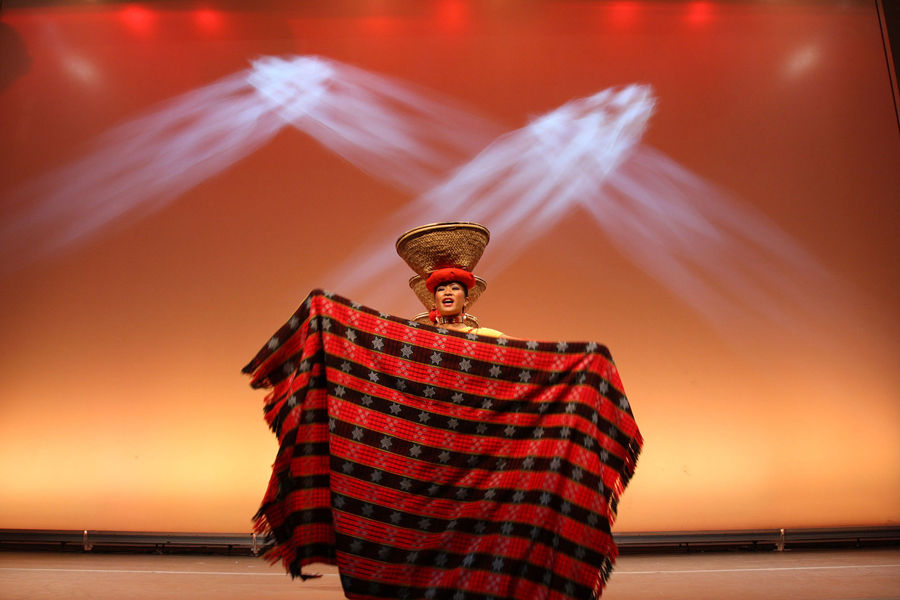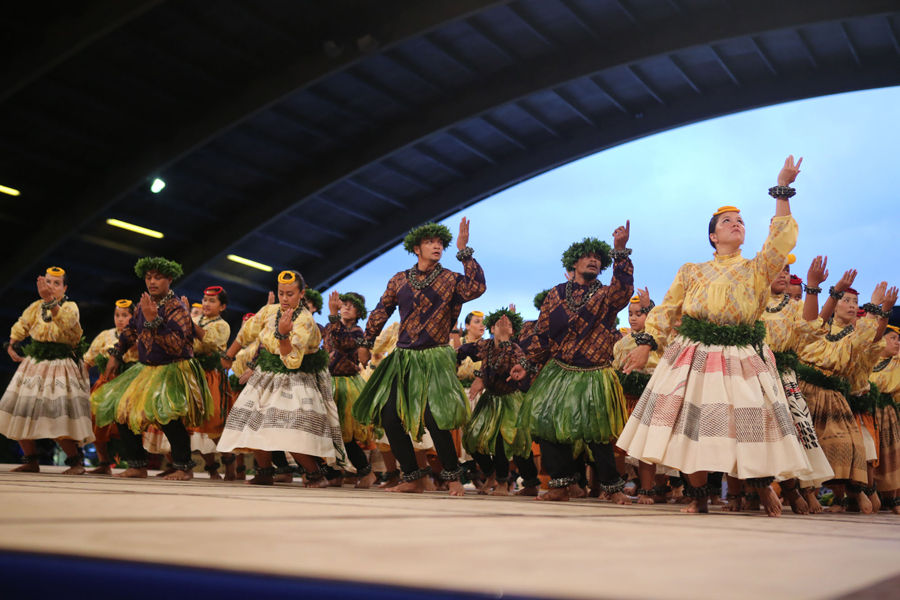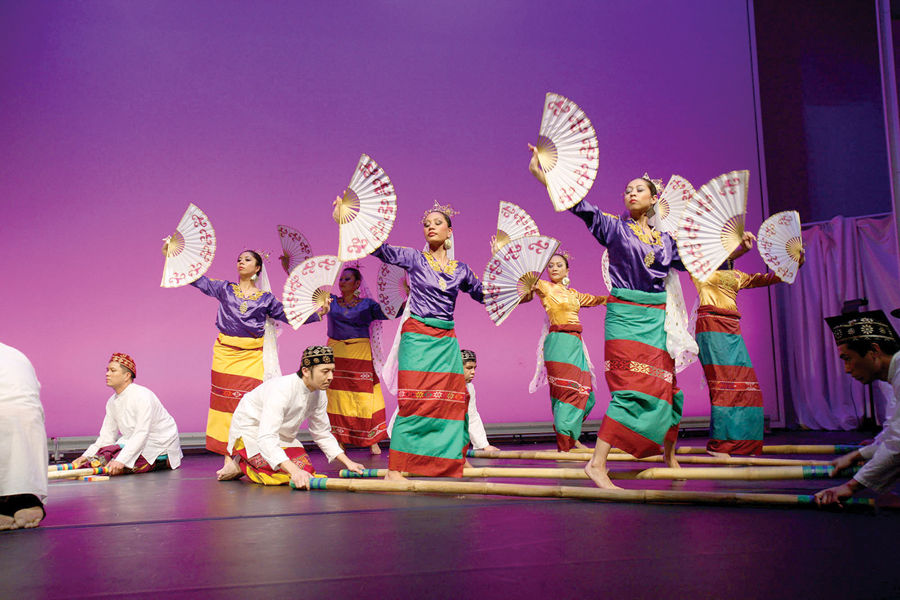HILO — Tonight’s Hoike isn’t part of the Merrie Monarch Festival’s hula competition, but for many, the free exhibition is a must. There are no tickets, and lines of people will form early around Edith Kanaka‘ole Multipurpose Stadium, hoping to
HILO — Tonight’s Hoike isn’t part of the Merrie Monarch Festival’s hula competition, but for many, the free exhibition is a must.
There are no tickets, and lines of people will form early around Edith Kanaka‘ole Multipurpose Stadium, hoping to be among the first-come, first-served, who’ll see live music and dance from various cultures across the Pacific.
Halau O Kekuhi will perform, as it has every year since 1997. The Hilo halau is directed by kumu hula and Merrie Monarch judge Nalani Kanaka‘ole, the daughter of Edith Kanaka‘ole.
Kanaka‘ole said the halau will perform the mele Pule Malaehaakoa, part of the Pele and Hi‘iaka legend, which includes Pele’s deification and her final settlement at Kilauea with establishment of her gods.
“In a featured hula, the kane dance with long hau strips on a handle used to strain awa in an awa ritual,” she said. “The same long hau strips will be used by the wahine to represent the cleansing of land by water. This year we feature the olapa and olapa keiki of the halau and joining us will be our sister halau from Hana (Maui) under the direction of Kumu Kaui Kanaka‘ole.”
Halau Ka Lei Mokihana O Leinaala from Kauai will depart for the Big Island today to take part in the festival.
Tupulaga O Samoa Mo A Taeao, the University of Hawaii at Hilo Samoan Club and a traditional mainstay of the school’s International Night, is also on the bill, as are two Tahitian dance groups, Te Mau Aito O Hiro and Tamariki Poerani Dance Academy.
Making its Merrie Monarch debut is Kayamanan Ng Lahi Philippine Folk Arts, a Los Angeles troupe celebrating its 25th anniversary this year.
Joel Jacinto, Kayamanan Ng Lahi’s program director, who co-founded the nonprofit organization with his wife, Ave, and Barbara Ele, notes it’s “the first time in the history of the Merrie Monarch Festival” that Philippine, Filipino-American and Filipino-Hawaiian culture will be honored on the festival’s stage.
Kayamanan Ng Lahi was brought to the attention of Merrie Monarch officials by Iris Gil Viacrusis, a Paris-trained local fashion designer of Filipino descent who creates gowns and uniforms worn by the festival’s royal court, said Jacinto. He described Villacrusis as “very much our champion.”
Jacinto said it is the troupe’s “kuleana to uplift the Filipino population in Hawaii, make them proud they are a part of the island heritage.”
As it turns out, Jacinto, an applied anthropologist, has a strong affinity for the Hawaiian culture. He was a graduate student at UH-Manoa in the 1980s.
As a haumana in the late kumu hula Frank Palani Kahala’s Gentlemen of Maluikeau, he participated in the Merrie Monarch’s silver anniversary in 1988.
“It was a dream of mine to be in a hula halau and to compete in the Merrie Monarch,” Jacinto said.
The theme of the four-part production is “Mana.”
“It is a shared lexicon found both in the Southeast Asian, especially the Filipino tradition, as well in the Pacific Islander, the idea of ‘mana,’” Jacinto said. “In the Philippines, it means inheritance or legacy, that which you get from your ancestors, but at one time it had the same meaning, ‘spiritual power,’ found in the Pacific Islander tradition.”
Jacinto said his troupe has 43 dancers, plus musicians and kokua.
There are three guest artists well-known to Hawaii folks. One, Abe Lagrimas Jr., is a Hoku-winning multi-instrumentalist originally from Waipahu, now living in Los Angeles. Another, Patrick Landeza of Berkeley, California, in 2013 became the first Mainland-born artist to win a Hoku for best slack-key album.
The third is Keali‘i Ceballos, kumu hula of Halau Keali‘i o Na Lani, a Los Angeles halau that’s made numerous Merrie Monarch appearances.
“Mana” is new but audience-tested material as the show debuted March 21 at the Aratani Theatre in Los Angeles.
“What we want to do in 50 minutes is to share the many and various subcultures in dance and musical traditions of the Philippines and of the Filipino experience in Hawaii. The music and dance we present on the stage is folk based. I’m an applied anthropologist, so I’ve studied both in the Philippines and Hawaii.” Jacinto said.
“The Filipino culture and the Hawaiian culture really are much closer than most people think. The mana, the idea that we receive it from our ancestors is something that is found in both our cultures.”
The first suite of “Mana” will draw from northern Philippine culture, including the Kalinga. Jacinto said the suite, including a “tableau of a traditional Filipino tattoo session ritual,” will be “familiar to Hawaiians because we have the same cultural practices.”
“We have a tattoo practitioner. His name is Lane Wilcken, who’s an author,” Jacinto said. “He’s one of the few people who hand-taps tattoos in the Filipino style and he’s being mentored by the leading Hawaiian practitioner, Keone Nunes.”
The second suite recognizes the 300-year-long Spanish colonization of the Philippines.
“The dances are more formal; they’re more secular,” Jacinto said. “There’s more a cultural strata layer to them, meaning the upper class, those who had the means, were able to dress as European and have the trappings of being a landed, or upper class, Filipino.”
The third suite focuses on the Sulu Archipelago in the southern Philippines, “including dances from the Maranao tradition.”
“There’s a very famous dance called the singkil. It’s sort of a dance of royalty, like a fairy tale come to life, with prince and princess and entourage,” Jacinto explained.
The final suite focuses on plantation culture in Hawaii in the late 1930s.
“There’s a wedding between a local girl and a Filipino boy. It’s a mixed marriage,” Jacinto said. “We’re going to be presenting dances that are more provincial, more rustic, more countrified, a more kanikapila kind of dance, very upbeat, very lively.”
Jacinto said the manao driving Kayamanan Ng Lahi’s repertoire is “to be a bridge between the village and the stage.”
“We want our material to educate as well as entertain,” he said. “So all of our material is anthropologic-based in traditional and folk culture. We also translate that for presentation onstage.”




